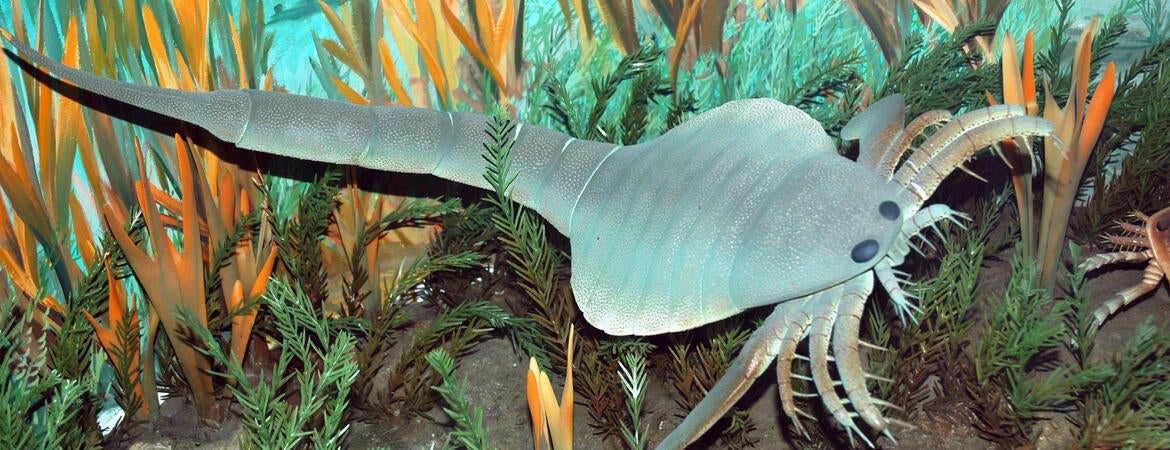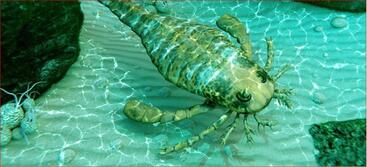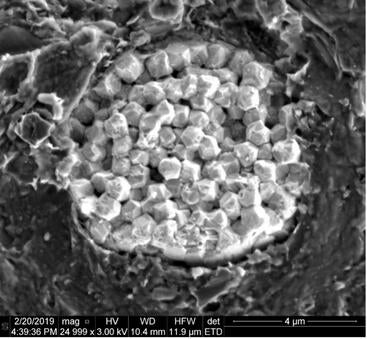
Trapped for millennia, the tiniest liquid remnants of an ancient inland sea have now been revealed. The surprising discovery of seawater sealed in what is now North America for 390 million years opens up a new avenue for understanding how oceans change and adapt with changing climate.
That period in Earth’s history is of great interest to scientists at UC Riverside because of the major changes that occurred then, including one of history’s largest extinctions and possibly the first oxygenation of the deep oceans following billions of years of oxygen-lean conditions.
Many types of minerals and gems contain small pockets of trapped liquid. Indeed, some gemstones are prized for their light-catching bubbles of liquid. What’s different in this study is that scientists were able to reveal what was inside the tiniest water pockets, using advanced microscopes and chemical analyses.
“We discovered we can actually dig out information from these mineral features that could help inform geologic studies, such as the chemistry of ancient oceans,” said Sandra Taylor, first author of the study and a materials scientist at the Department of Energy’s Pacific Northwest National Laboratory.
Taylor worked with laboratory colleagues Daniel Perea, John Cliff, and Libor Kovarik to perform the analyses in collaboration with geochemists Daniel Gregory of the University of Toronto and Timothy Lyons of the UCR Department of Earth and Planetary Sciences. The research team reported their discovery in the December 2022 issue of Earth and Planetary Science Letters.
The team’s findings confirmed that the water trapped inside the rock fit the chemistry profile of an ancient inland saltwater sea that once occupied Upstate New York, where the rock originated.
During the so-called Middle Devonian period, this inland sea stretched from present day Michigan to Ontario, Canada. It harbored a coral reef to rival Australia’s Great Barrier Reef. Sea scorpions the size of a pickup truck patrolled waters that harbored now-extinct creatures like trilobites and the earliest examples of horseshoe crabs.
Eventually the oceans receded, many of the creatures became extinct, and the sea itself also disappeared, leaving behind only fossil remains embedded in sediments. These fossils became the samples used in the current experiment.
Scientists use rock samples to piece together how climate changes over the long span of geologic time.
“We use mineral deposits to estimate the temperature of the ancient oceans,” said Gregory, a geologist at the University of Toronto, former UCR postdoctoral student, and one of the study leaders. But there are relatively few examples useful for exploring Earth’s earliest chapters.
“Salt deposits from trapped seawater are relatively rare in the rock record, so there are millions of years missing in the records, and what we currently know is based on a few localities where the salt is found,” Gregory said. By contrast, pyrite is found everywhere. “Sampling with this technique could open up millions of years of the geologic record and lead to new understanding of changing climate.”
Lyons added “pyrite has offered us a surprisingly large window to Earth’s ancient environments, life, and oceans, and this novel approach may have the greatest potential. It’s exciting to explore the range of possible applications and their implications.”
Often referred to as fool’s gold, UCR scientists have been working with pyrite for more than a decade to explore important but elusive details about Earth history and pyrite’s potential impact on the environment today. They proposed the project, assisted in analyses, and provided samples for this study. The discovery of the preserved seawater in the pyrite was an entirely unexpected result.
The research team was pursuing another environmental issue—toxic arsenic leaching from rock—when they noticed the tiny defects. Scientists describe the analyzed pyrite grains as framboids—for framboise, the French word for raspberry—because of their raspberry-like appearance under the microscope.
“We looked at these samples through the electron microscope first, and we saw mini bubbles or other features within the framboid and wondered what they were,” Taylor said.
Using the very sensitive detection techniques of atom probe tomography and mass spectrometry—which can detect minuscule amounts of elements or impurities in minerals—the team worked out that the bubbles indeed contained water, along with salt chemistry matching that from ancient seas.
“I can’t wait to see what else we find in pyrite of different ages from around the world,” notes Lyons. This is a completely new way to explore Earth history over millions of years. “Who’s the fool now,” he quips.
This research was conducted at the Environmental Molecular Sciences Laboratory located at PNNL. Lyons and Gregory used the facility through a competitive application process. The research was also supported by grants from the Natural Sciences and Engineering Research Council of Canada and NASA.
(Text: PNNL and Tim Lyons; Eurypterid cover image: James St. John)





